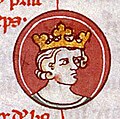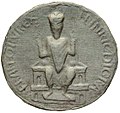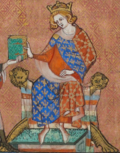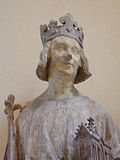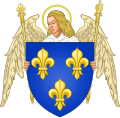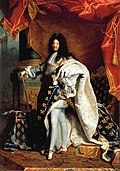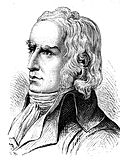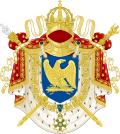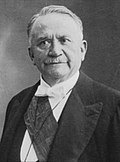Top Qs
Timeline
Chat
Perspective
List of heads of state of France
From Wikipedia, the free encyclopedia
Remove ads
Monarchs ruled the Kingdom of France from the establishment of Francia in 481 to 1870, except for certain periods from 1792 to 1852. Since 1870, the head of state has been the President of France. Below is a list of all French heads of state. It includes the kings of the Franks, the monarchs of the Kingdom of France, emperors of the First and Second Empire and leaders of the five Republics.
Carolingian dynasty (843–888)
Summarize
Perspective
The Carolingians were a Frankish noble family with origins in the Arnulfing and Pippinid clans of the 7th century AD. The family consolidated its power in the 8th century, eventually making the offices of mayor of the palace and dux et princeps Francorum hereditary and becoming the real powers behind the Merovingian kings. The dynasty is named after one of these mayors of the palace, Charles Martel, whose son Pepin the Short dethroned the Merovingians in 751 and, with the consent of the Papacy and the aristocracy, was crowned King of the Franks.[1] Under Charles the Great (r. 768–814), better known as "Charlemagne", the Frankish kingdom expanded deep into Central Europe, conquering Italy and most of modern Germany. He was succeeded by his son Louis the Pious (r. 814–840), who eventually divided the kingdom between his sons. His death, however, was followed by a 3-year-long civil war that ended with the Treaty of Verdun. Modern France developed from West Francia, while East Francia became the Holy Roman Empire and later Germany.
Louis the Pious made many divisions of the Carolingian Empire during his lifetime. The final division, pronounced at Worms in 838, made Charles the Bald heir to the west, including Aquitaine, and Lothair heir to the east, including Italy and excluding Bavaria, which was left for Louis the German. However, following the emperor's death in 840, the empire was plunged into a civil war that lasted three years. The Frankish kingdom was then divided by the Treaty of Verdun in 843. Lothair was allowed to keep his imperial title and his kingdom of Italy, and granted the Middle Francia, a corridor of land stretching from Italy to the North Sea, and including the Low Countries, the Rhineland (including Aachen), Burgundy, and Provence. Charles was confirmed in Aquitaine, where Pepin I's son Pepin II was opposing him, and granted West Francia (modern France), the lands west of Lothair's Kingdom. Louis the German was confirmed in Bavaria and granted East Francia (modern Germany), the lands east of Lothair's kingdom.
Remove ads
Robertian dynasty (888–898)
Remove ads
Carolingian dynasty (898–922)
Robertian dynasty (922–923)
Bosonid dynasty (923–936)
Remove ads
Carolingian dynasty (936–987)
Remove ads
Capetian dynasty (987–1792)
Summarize
Perspective
The Capetian dynasty is named for Hugh Capet, a Robertian who served as Duke of the Franks and was elected King in 987. Except for the Bonaparte-led Empires, every monarch of France was a male-line descendant of Hugh Capet. The kingship passed through patrilineally from father to son until the 14th century, a period known as Direct Capetian rule. Afterwards, it passed to the House of Valois, a cadet branch that descended from Philip III. The Valois claim was disputed by Edward III, the Plantagenet king of England who claimed himself as the rightful king of France through his French mother Isabella; the two houses fought the Hundred Years' War over the issue, and with Henry VI of England being for a time partially recognized as King of France. The Valois line died out in the late 16th century, during the French Wars of Religion, to be replaced by the distantly related House of Bourbon, which descended through the Direct Capetian Louis IX. The Bourbons would rule France until deposed in the French Revolution, though they would be restored to the throne after the fall of Napoleon. The last Capetian to rule would be Louis Philippe I, king of the July Monarchy (1830–1848), a member of the cadet House of Bourbon-Orléans.
House of Capet (987–1328)
The House of Capet are also commonly known as the "Direct Capetians".
House of Valois (1328–1589)
The death of Charles IV started the Hundred Years' War between the House of Valois and the House of Plantagenet, whose claim was taken up by the cadet branch known as the House of Lancaster, over control of the French throne. The Valois claimed the right to the succession by male-only primogeniture through the ancient Salic Law, having the closest all-male line of descent from a recent French king. They were descended from the third son of Philip III, Charles, Count of Valois. The Plantagenets based their claim on being closer to a more recent French king, Edward III of England being a grandson of Philip IV through his mother, Isabella.
The two houses fought the Hundred Years War to enforce their claims. The Valois were ultimately successful, and French historiography counts their leaders as rightful kings. One Plantagenet, Henry VI of England, enjoyed de jure control of the French throne following the Treaty of Troyes, which formed the basis for continued English claims to the throne of France until 1801. The Valois line ruled France until the line became extinct in 1589, in the backdrop of the French Wars of Religion. As Navarre did not have a tradition of male-only primogeniture, the Navarrese monarchy became distinct from the French with Joan II, a daughter of Louis X.
House of Valois-Orléans (1498–1515)
House of Valois-Angoulême (1515–1589)
House of Bourbon (1589–1792)
The Valois line looked strong on the death of Henry II, who left four male heirs. His first son, Francis II, died in his minority. His second son, Charles IX, had no legitimate sons to inherit. Following the premature death of his fourth son Hercule François and the assassination of his third son, the childless Henry III, France was plunged into a succession crisis over which distant cousin of the king would inherit the throne. The best claimant, King Henry III of Navarre, was a Protestant, and thus unacceptable to much of the French nobility.
Ultimately, after winning numerous battles in defence of his claim, Henry converted to Catholicism and was crowned as King Henry IV, founding the House of Bourbon. This marked the second time the thrones of Navarre and France were united under one monarch, as different inheritance laws had caused them to become separated during the events of the Hundred Years Wars. The House of Bourbon was overthrown during the French Revolution and replaced by a short-lived republic.
Remove ads
First Republic (1792–1804)
Summarize
Perspective
National Convention
From 22 September 1792 to 2 November 1795, the French Republic was governed by the National Convention, whose president (elected from within for a 14-day term) may be considered as France's legitimate head of state during this period. Historians generally divide the Convention's activities into three periods, moderate, radical, and reaction, and the policies of presidents of the Convention reflect these distinctions. During the radical and reaction phases, some of the presidents were executed, most by guillotine, committed suicide, or were deported. In addition, some of the presidents were later deported during the Bourbon Restoration in 1815.
Moderate phase
Initially, La Marais, or The Plain, a moderate, amorphous group, controlled the Convention. At the first session, held on 20 September 1792, the elder statesman Philippe Rühl presided over the session. The following day, amidst profound silence, the proposition was put to the assembly, "That royalty be abolished in France"; it carried, with cheers. On the 22nd came the news of the Republic's victory at the Battle of Valmy. On the same day, the Convention decreed that "in future, the acts of the assembly shall be dated First Year of the French Republic". Three days later, the Convention added the corollary of "the French republic is one and indivisible", to guard against federalism.[83]
The following men were elected for two-week terms as presidents, or executives, of the Convention.[84]
At the end of May 1793, an uprising of the Parisian sans culottes, the day-laborers and working class, undermined much of the authority of the moderate Girondins.[85] At this point, although Danton and Hérault de Séchelles both served one more term each as Presidents of the Convention, the Girondins had lost control of the Convention: in June and July compromise after compromise changed the course of the revolution from a bourgeois event to a radical, working class event. Price controls were introduced and a minimum wage guaranteed to workers and soldiers. Over the course of the summer, the government became truly revolutionary.[86]
Radical phase
After the insurrection, any attempted resistance to revolutionary ideals was crushed. The insurrection of 31 May – 2 June 1793 marked a significant milestone in the history of the French Revolution. The days of 31 May – 2 June (French: journées) resulted in the fall of the Girondin party under pressure of the Parisian sans-culottes, Jacobins of the clubs, and Montagnards in the National Convention. The following men were elected as presidents of the Convention during its transition from its moderate to radical phase.[87]
The following men were elected as presidents of the Convention during its radical phase.[87]
Reaction
On 27 July 1794, the National Convention voted for the arrest of Maximilien Robespierre, Louis Antoine de Saint-Just, and several allies, and they were executed the following day. This ended the most radical phase of the French Revolution.[88][Notes 2]
The following men were presidents of the Convention until its end.[87]
Directory
The Directory was officially led by a president, as stipulated by Article 141 of the Constitution of the Year III. An entirely ceremonial post, the first president was Jean-François Rewbell, who was chosen by lot on 2 November 1795. The Directors conducted their elections privately, with the presidency rotating every three months.[89] The last President was Louis-Jérôme Gohier.[90]
The leading figure of the Directory was Paul Barras, the only director to serve throughout the Directory.
- Political parties
Centre (Thermidorians) Right-wing (Clichyens) Left-wing (Montagnards) Other (Maraisards)
After the Coup of 18 Brumaire (9 November 1799), Barras, Ducos, and Sieyès resigned.
Moulin and Gohier, refusing to resign, were arrested by General Moreau.
Consulate
Napoléon Bonaparte proclaimed himself Emperor of the French in 1804, reigning as Emperor Napoleon I 1804–1814 (First French Empire) and 1815 (Hundred Days).
The monarchy was restored 1814–1815 and 1815–1830 (Bourbon Restoration); again 1830–1848 (July Monarchy).
Remove ads
House of Bonaparte, First French Empire (1804–1814)
House of Bourbon, First Restoration (1814–1815)
Remove ads
House of Bonaparte, Hundred Days (1815)
Remove ads
House of Bourbon, Second Restoration (1815–1830)
House of Bourbon-Orléans, July Monarchy (1830–1848)
The Bourbon Restoration came to an end with the July Revolution of 1830 which deposed Charles X and replaced him with Louis Philippe I, a distant cousin with more liberal politics. Charles X's son Louis signed a document renouncing his own right to the throne only after a 20-minute argument with his father. Because he was never crowned he is disputed as a genuine king of France. Louis's nephew Henry was likewise considered by some to be Henry V, but the new regime did not recognise his claim and he never ruled.
Charles X named Louis Philippe as Lieutenant général du royaume, a regent to the young Henry V, and charged him to announce his desire to have his grandson succeed him to the Chamber of Deputies, the lower house of the French Parliament at the time, the French equivalent at the time of the UK House of Commons. Louis Philippe did not do this, in order to increase his own chances of succession. As a consequence, and because the French parliamentarians were aware of his liberal policies and of his popularity at the time with the French population, they proclaimed Louis Philippe as the new French king, displacing the senior branch of the House of Bourbon.
Second Republic (1848–1852)
President of the Provisional Government of the Republic
- Political parties
President of the Executive Commission
- Political parties
Moderate Republicans
Chief of the Executive Power
- Political parties
Moderate Republicans
President of the Republic
- Political parties
Louis-Napoléon Bonaparte proclaimed himself Emperor of the French in 1852, reigning as Emperor Napoleon III 1852–1870 (Second French Empire).
House of Bonaparte, Second Empire (1852–1870)
The French Second Republic lasted from 1848 to 1852, when its president, Charles-Louis-Napoléon Bonaparte, was declared Emperor of the French under the regnal name of Napoleon III. He would later be overthrown during the events of the Franco-Prussian War, becoming the last monarch to rule France.
Third Republic (1870–1940)
President of the Government of National Defense
- Political parties
Chief of the Executive Power
- Political parties
Presidents of the Republic
- Political parties
Monarchist
Moderate Republican
Democratic Republican Alliance; Democratic Republican Party; Social and Republican Democratic Party; Democratic Alliance
Radical-Socialist and Radical Republican Party
Independent
The office of President of the French Republic did not exist from 1940 until 1947.
French State (1940–1944)
Chief of State
Provisional Government of the French Republic (1944–1946)
Chairmen of the Provisional Government
Political parties Socialist (SFIO) Centre-right (MRP)
Fourth Republic (1946–1958)
Presidents
Political parties
Socialist (SFIO) Centre-right (CNIP)
Fifth Republic (1958–present)
Presidents
Political parties: Centre-left (PS) (2) Centrist (RE) (1) Centre-right (CD; RI; PR; UDF) (1) Gaullist (UNR; UDR) (2) Neo-Gaullist (RPR; UMP; LR) (2)
Later pretenders
Summarize
Perspective
Various pretenders descended from the preceding monarchs have claimed to be the legitimate monarch of France, rejecting the claims of the President of France, and of each other. These groups are:
- Legitimist claimants to the throne of France: descendants of the Bourbons, rejecting all heads of state 1792–1814, 1815, and since 1830. Unionists recognized the Orléanist claimant after 1883.
- Legitimist-Anjou claimants to the throne of France: descendants of Louis XIV, claiming precedence over the House of Orléans by virtue of primogeniture
- Orléanist claimants to the throne of France: descendants of Louis-Phillippe, himself descended from a junior line of the Bourbon dynasty, rejecting all heads of state since 1848.
- Bonapartist claimants to the throne of France: descendants of Napoleon I and his brothers, rejecting all heads of state 1815–48, and since 1870.
- English claimants to the throne of France: Kings of England and later, of Great Britain (renounced by Hanoverian King George III upon union with Ireland)
- Jacobite claimants to the throne of France: senior heirs-general of King Edward III of England and thus his claim to the French throne, also claiming England, Scotland, and Ireland.
Timeline
481–1795

1792–Present

See also
- List of French monarchs
- List of presidents of the National Convention
- List of presidents of France
- Ministers of the French National Convention
- Representative on mission
- Full list of members of the Convention per department: List of members of the National Convention by Department (French)
- List of foreign ministers of France
- List of prime ministers of France
- President of France
- British claims to the French throne
- Kings of France family tree
- Style of the French sovereign
Notes, citations and sources
Wikiwand - on
Seamless Wikipedia browsing. On steroids.
Remove ads








